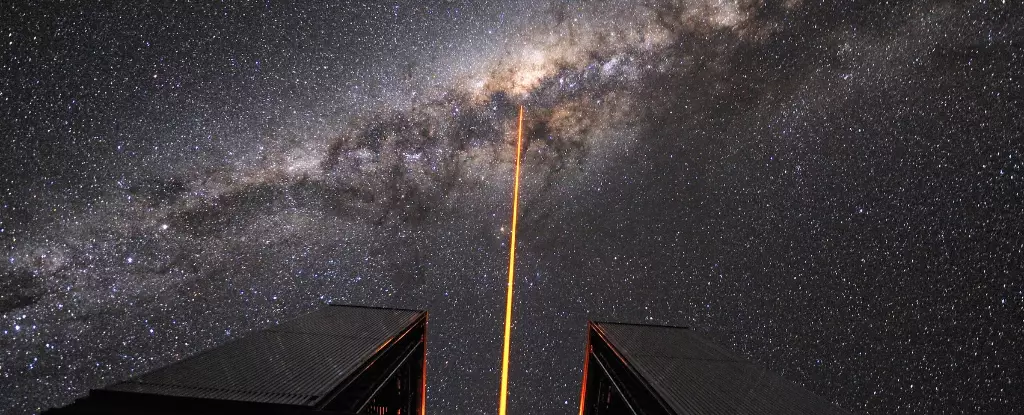At the heart of our galaxy, the Milky Way, dwells a colossal entity known as Sagittarius A*, a supermassive black hole whose gravitational pull reigns supreme. Located roughly 27,000 light years from Earth, this behemoth boasts an astounding diameter of approximately 23.5 million kilometers. The intriguing nature of Sagittarius A* has long captivated astronomers, but recent groundbreaking discoveries have catalyzed a deeper understanding of its surroundings, particularly through the identification of a binary star system that orbits this mysterious black hole.
In a pioneering endeavor led by astronomer Florian Peißker and his team at the University of Cologne, researchers have unraveled a cosmic enigma by successfully identifying a binary star system situated in proximity to Sagittarius A*. This revelation marks a significant milestone in astronomical studies, especially concerning the longstanding question of why certain stars exhibit extraordinary speeds as they traverse the cosmos. Unlike our solitary Sun, which exists independently and is therefore exposed to fewer gravitational disruptions, binary systems—consisting of two stars that orbit each other—represent a different dynamic, one that presents a wealth of information about stellar behavior.
Significantly, binary star systems provide astronomers with critical data that goes beyond mere observation. By analyzing the motion and interactions of these stars, researchers can deduce vital information such as mass and distance—metrics that are often more challenging to ascertain from solitary stars due to their lack of comparative motion. It is estimated that approximately two-thirds of the stars within the Milky Way are solitary, while the remainder are members of binary or even multiple star systems. Notably, larger stars are more prone to exist in pairs, offering astronomers an exciting avenue to better understand stellar evolution and dynamics.
The detection of the binary star system orbiting Sagittarius A* was not achieved through conventional direct observation. Instead, the astronomers harnessed the power of the European Southern Observatory’s Very Large Telescope, employing the Doppler effect to observe minute shifts in the starlight. This innovative approach unveiled characteristic wobbles in the light emitted by the stars, illuminating their orbits around the black hole. Through careful analysis, the researchers were able to ascertain that these stars are approximately 2.7 million years old—a testament to their survival in the hostile, gravity-laden environment surrounding Sagittarius A*.
The intricate relationship between black holes and their surrounding stellar systems prompts comparisons to more familiar celestial motions, such as that of the Earth and the Moon orbiting the Sun. Gravitational forces dictate that multiple entities can become locked in complex orbits, with stability often hinging on their proximity to one another. In systems with three bodies, interactions can lead to destabilization, resulting in scenarios where one body is ejected completely from the group—a concept illustrated compellingly in science fiction narratives like “The Three Body Problem.”
This gravitational interplay might elucidate a captivating cosmic phenomenon known as hypervelocity stars, which are known to traverse the Milky Way at extraordinary speeds exceeding 1,000 kilometers per second. Researchers propose that these stars were once part of a binary system that drifted perilously close to Sagittarius A*, leading to one star’s ejection and subsequent journey into the galaxy’s outer realms.
The challenge lies in verifying hypotheses regarding hypervelocity stars and their origins. The presence of a binary star system around Sagittarius A* serves as a pivotal piece of evidence in understanding these high-speed celestial objects. Astronomers have devoted extensive effort to monitoring the galactic center for decades, utilizing both traditional stargazing techniques and modern technological advancements like astronomy apps to locate Sagittarius A*.
The identification of this newly discovered binary star system not only enriches the scientific narrative surrounding black holes but also supports existing theories concerning stellar ejection processes. This becomes more exciting as astronomers continue their quest to decipher the complexities of cosmic structures and their interconnectedness within our galaxy.
The discovery of a binary star system orbiting Sagittarius A* enhances our understanding of the cosmos, pushing the boundaries of what we know about stellar dynamics and the nature of black holes. As each revelation unveils intricate relationships within the universe, it becomes increasingly clear that our grasp of these phenomena is still evolving. Through ongoing research and innovative techniques, astronomers are contributing vital pieces to the grand puzzle of cosmic evolution, transforming our perspective of the universe one discovery at a time.

